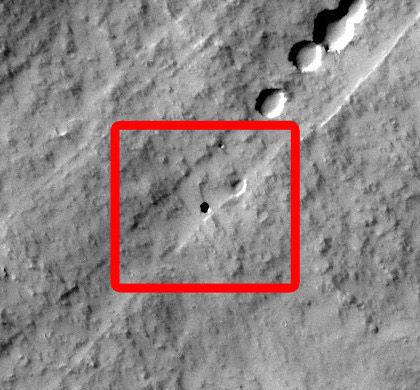| Tikalon Blog is now in archive mode.
An easily printed and saved version of this article, and a link
to a directory of all articles, can be found below: |
|
This article |
| Directory of all articles |
The Caves of Mars
July 23, 2010
Edgar Rice Burroughs wrote
Tarzan, but he's also famous for putting
John Carter on
Mars. Among the titles in Burroughs'
Martian series of books are
The Gods of Mars,
The Warlord of Mars,
The Chessmen of Mars and
The Master Mind of Mars; so, "The Caves of Mars" sounds like something Burroughs may have written. Burroughs didn't write such a book. Instead, it's being written today by a group of precocious seventh grade science students in
Cottonwood, California.
As I wrote in a
previous article (Lousy Science Yields Good Art, June 25, 2010), scientists are drowning in data. There's so much data in some specialties that it isn't possible for scientists to review it all, so they've been asking for help from the general public. One example of such outreach is the
Galaxy Zoo, where anyone can help classify the multitude of galaxies photographed by the
Hubble Space Telescope. So far, a quarter of a million people have participated in the Galaxy Zoo classification project.

THEMIS image of a candidate cave opening on Mars
The seventh grade students from Evergreen Middle School were mentored by the
Mars Student Imaging Program of
Arizona State University. They decided to see whether
lava tubes on Mars occur more often at the summits of volcanoes, at their flanks, or in the surrounding areas. To do this, they examined about two hundred
THEMIS images of Mars. THEMIS, an acronym for Thermal Emission Imaging System, is a camera system on
NASA's Mars Odyssey orbiter that collects image data from visible light wavelengths through to the far infrared (14.9 micrometers). The visible images have a resolution of about sixty feet, or the size of a small house. The photographs were in the area of the Martian volcano,
Pavonis Mons.[1]
One image showed a black spot (see photograph) indicative of a hole with steep vertical walls. The hole is estimated to be almost 600 feet in diameter, and at least 380 feet deep. The hole may be an example of a "skylight;" that is, a collapsed part of the roof of a cave or a lava tube. The students have petitioned to have this hole imaged at higher resolution by the
Mars Reconnaissance Orbiter. Such images have one foot resolution, which is enough to allow a close examination of what might be inside the hole.
Are lava tubes a mere curiosity, or could they be important to space exploration? We
Earthlings are lucky that our atmosphere and
magnetosphere shield us from most dangerous radiation and space debris. The surface of our moon and Mars, however, are bathed in
cosmic rays, intense radiation from the sun, and
micrometeorites. Lava tubes would provide protection from all these, and they would also maintain a constant temperature, since their underground location shields them from surface temperature variations.
References:
- Robert Burnham, "Middle-school project discovers cave skylight on Mars," School of Earth and Space Exploration, Arizona State University, June 17, 2010.
- Ray Villard, "Subterranean Living May Await Moon and Mars Colonists," Discovery Magazine Online, July 18, 2010.
Permanent Link to this article